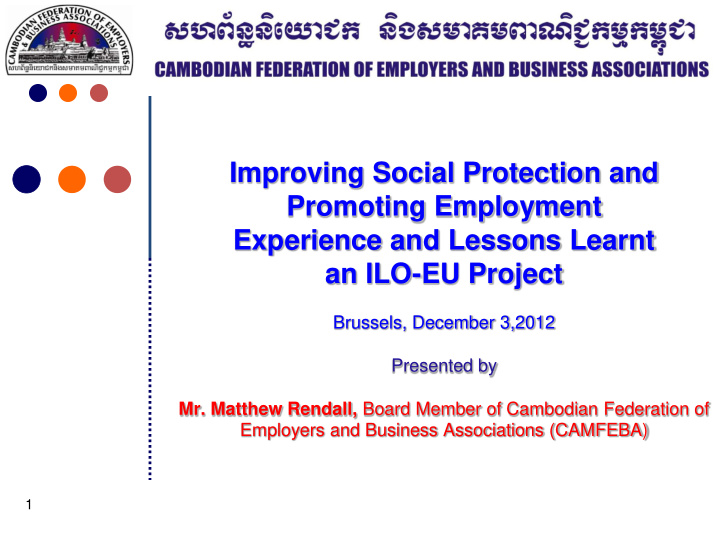



Improving Social Protection and Promoting Employment Experience and Lessons Learnt an ILO-EU Project Brussels, December 3,2012 Presented by Mr. Matthew Rendall, Board Member of Cambodian Federation of Employers and Business Associations (CAMFEBA) 1
Content CAMFEBA Background 1. Lessons Learnt from Cambodia (CAMFEBA): 2 aspects 2. Social Protection Promoting Employment Slide 2
CAMFEBA’s Background The Cambodian Federation of Employers and Business Associations (CAMFEBA), established on 13 June 2000, is an autonomous and independent sole federation of employers and Business Associations recognized and registered with the Ministry of Labor and Vocational Training of Cambodia. CAMFEBA provides a forum for consultation and discussion among members on matters of common interest, and seeks for the adoption of sound principles and practices of human resource and industrial relations through information, legal advice, research, training and other activities. Slide 3
CAMFEBA’s Background 6 Business Associations as Association members, 180 individual companies as individual members 19 non-profit organizations as the Associate members. Slide 4
CAMFEBA’s Background CAMFEBA’s Vision : “Successful Business, Prosperous Cambodia” CAMFEBA’s Mission: “We are the federation of employers and Business Associations. We promote the environment for successful business growth and support employers to achieve excellence in business practices. ” Slide 5
Social Protection The Labour Law, adopted in October 1997, provides the legal framework for the protection of workers and employees. Minimum of social security benefits to be granted to all employees by their employer; and a minimum wage for different economic sectors to be set by MOLVT via a Prakas (ministerial regulation) through recommendation from the tripartite Labour Advisory Committee (LAC) Slide 6
Social Protection The social security benefits mandated by the Labour Law include the following: Employment injury benefits: a. Maternity leave: b. Sick leave: c. Severance pay: d. Slide 7
Social Protection Law on Social Security Scheme for workers covered under the Labour Law was enacted in 2002: National Social Security Fund (NSSF) law stipulates the introduction of the following social security benefit: a compensation fund for victims of employment injuries a. and occupational diseases; a pension insurance fund (not yet set as it is under the b. process regarding the pension for private sector employees); and other benefit branches as relevant c. Slide 8
NSSF Coverage:It can be observed that the total number of employees insured in 2010 was about 480,000, among whom were about 373,000 workers (78 per cent) in the garment and footwear industry. No. of workers insured 1 Economic sector 2009 2010 274 911 373 445 Garment and footwear industries 5 808 13 031 Manufacturing (other) 1 171 2 188 Mining and construction 5 501 9 344 Transport and telecommunications 3 369 7 108 Wholesale and retail trade 31 148 75 330 Services 321 908 480 446 Total (all sectors) Source: National Social Security Fund of Cambodia, IT Division. Slide 9
NSSF Benefits: besides the workplace accidents and work- related diseases, including road accidents during commutes between home and work, it is also included: Medical care (in-kind) Nursing cash allowance Temporary disability allowance (income replacement benefit) Funeral (death) benefit Permanent disability benefit (pension) and caretaker benefit Survivor benefit (pension) Rehabilitation benefit (in-kind) Slide 10
NSSF Financing: Employers contribute to NSSF to cover the risk of employee injuries. (4,000 R = 1$) Monthly Wage (Riel) Assumed Wage (Riel) Contribution (Riel) Below 200,000 200,000 1,600 225,000 1,800 200,001-250,000 250,001-300,000 275,000 2,200 300,001-350,000 325,000 2,600 350,001-400,000 375,000 3,000 400,001-450,000 425,000 3,400 475,000 3,800 459,001-500,000 500,001-550,000 525,000 4,200 550,001-600,000 575,000 4,600 625,000 5,000 600,001-650,000 650,001-700,000 675,000 5,400 700,001-750,000 725,000 5,800 775,000 6,200 750,001-800,000 800,001-850,000 825,000 6,600 850,001-900,000 875,000 7,000 900,001-950,000 925,000 7,400 950,001-1,000,000 975,000 7,800 1,000,000 8,000 Slide 11 1,000,001 up
Promoting Employment Overview : High rates of illiteracy and low levels of education mean that many of them lack core work skills. Global trade and technological change, including the spread of information technology, have transformed the modern workplace and created a demand for new skills among workers. (Cambodian Workers lack those skills = skill mismatch) Slide 12
Promoting Employment Approaches and Experience: Government Employers Workers Develop a national Improve basic education and Eliminating illiteracy and training policy for all vocation training, including improve skills development Cambodians core work skills at all levels that are in line Set up a national training Establish a training committee with basic rights outlined in system, including a within the CAMFEBA and the Constitution qualifications frame work organize a survey of present Recognize locally acquired Strengthen systems for and future skills needs qualifications in Cambodia improving the quality of Establish links between the and abroad skills training companies and the National Improve the quality of Establish partnerships to Training Board training and the skills of the improve skill workforce so that workers are not considered “cheap development labour ” Slide 13
Promoting Employment The experiences to cope with this employment matter resulted as follows: National Training Board (NTB) has been vested with the bunches of significant responsibilities. National Employment Agency (NEA) has been created and is studying on the skill mismatch issues. National Employment Policy has been put at the top priority to be developed. Technical & Vocational Education and Training (TVET) has been strengthened to respond to the global demand for a skilled workforce. Slide 14
Thank for Your Attention!!! Slide 15
Recommend
More recommend